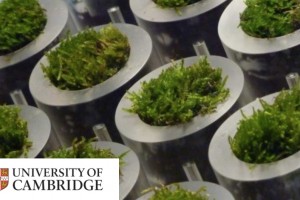Plant Power: Cambridge Scientists Generate Electricity from Photosynthesis
By Nora Al Baghdadi
Solar and wind power may have a new clean and renewable competitor in the form of plants. An article from the Cambridge University website called The Hidden Power of Moss explains how a team of Cambridge University Scientists want to show the world how they can generate renewable energy using natural waste from green plants. This emerging technology is technically called biophotovoltaics, or BPV, and it uses natural plant photosynthesis to generate electricity. Three scientists from the university, Alex Driver, Carlos Peralta, and Paolo Bombelli, created a table to demonstrate the process and create a prototype for future research.
Photosynthesis happens all around us every day. As every school child learns, plants use carbon dioxide and sunlight to produce the energy that they need to grow and thrive. During this process, some byproducts, including electrons, are released back into the soil or water that they grow in. It is these electrons that the scientists have devised a way to capture in order to produce an electric current that could power devices.
In the future, they hope this technology could even power entire buildings or maybe collections of buildings. Today, the scientists have only produced a small electric current, but they hope that this work gets developed and continued on a much larger scale in the future.
Right now, the scientists say that this technology is still in the conceptual stage of development. But the designers say that their moss table helps people visualize a possible future in which power needs could be supplied by a hybrid of organic and synthetic devices in an environmentally friendly and renewable manner. At first, it might be difficult to visualize how this small table with a small electric current can provide information that can be transferred to real-world applications.
The designers picture a variety of different solutions, and these include rooftop solar cells, covered with moss or other plants, that help generate power to homes and other types of buildings. Instead of using solar power directly like today’s typical solar panels, these rooftop panels would hold and grow plants to convert carbon dioxide and sunlight into electric current.
This technology is not just limited to producing electricity. It might also help turn seawater into fresh water. They visualize an entire power station made up of floating plants on the surface of the ocean. In fact, desalinated water could be another by product of this process, so the scientists are hopeful that a biological seaside power station could produce both fresh water and electricity.
This pioneering work involves collaboration between different departments at Cambridge University and Bath University. As the application required the knowledge of different scientific and technical disciplines, it included team members from departments of biochemistry, plant science chemical engineering, and biotechnology. The research has been funded by the Engineering and Physical Sciences Research Council, known as EPSRC. Team leaders include Professor Christopher Howe, Dr. Adrain Fisher, and Professor Allison Smith of Cambridge and Dr. Petra Cameron from Bath.
The team at Cambridge admitted that the work is in its very early stages. The first simple table does not provide enough power to run large appliances. It might be interesting to visualize a future when your plant covered night stand could recharge you cell phone and power your alarm clock from energy that it can gather from the sun streaming through the window. The scientists say that their main function is to come up with new alternatives and demonstrate that they are worth developing in the future.
Search
News

رئيس جامعة الناصر الاستاذ الدكتور عبدالله حسين طاهش يقوم بزيارة تفقدية للجان والقاعات الامتحانية الخاصة بكلية الهندسة وعلوم الحاسوب الاثنين 24 فبراير 2025
قام رئيس الجامعة الاستاذ الدكتور عبدالله حسين ط...
جامعة الناصر تنظم ورشة حول التهيئة الرمضانية لمنتسبيها
نظمت جامعة الناصر صباح اليوم الأثنين 25 شعبان 1...
اختتام المؤتمر العلمي الأول للجامعات اليمنية في صنعاء
اختتم اليوم في العاصمة صنعاء، أعمال المؤتمر الع...
لليوم الثاني على التوالي، استمرار أعمال ونقاشات المؤتمر العلمي الأول للجامعات اليمنية.
تستمر في العاصمة صنعاء لليوم الثاني على التوالي...
بمشاركة جامعة الناصر وبحضور رسمي رفيع انطلاق المؤتمر العلمي الأول في صنعاء
صنعاء 20 شعبان 1446 هجرية الموافق 18 فبراير 202...

